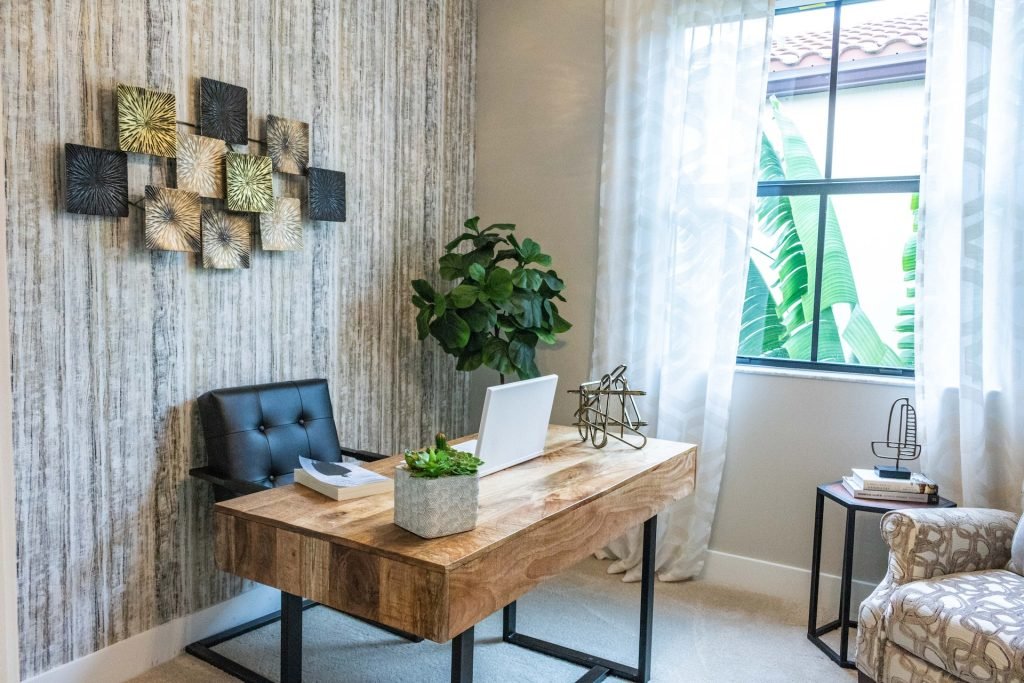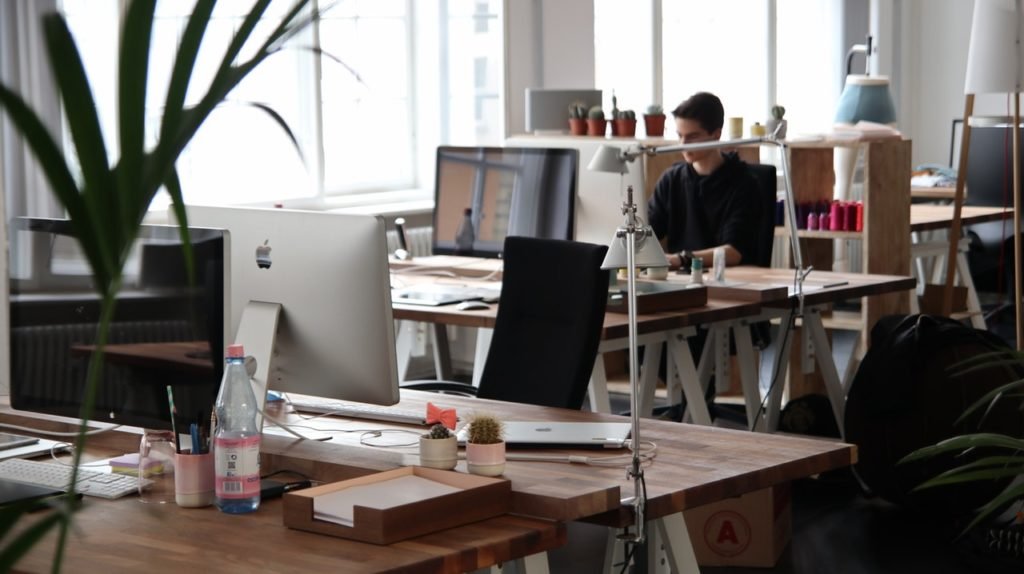How To Design Your Work From Home Office
For many, working from home (WFH) has become the new norm and a home office is now an essential space in your home. Whether your job allows you to spend intermittent days or the entire week in a more personal environment, creating an office space that will both accommodate your needs and encourage optimal focus and productivity is key.
In a normal business domain, the average person encounters a plethora of daily disruptions from stopping to catch up with a co-worker to phones ringing off the hook.
But in a home office space surrounded by family, pets, pending errands, comfortable sofas and the endless temptation of different forms of multi-media entertainment, being in “work mode” it’s a near impossible mission without the help of a well-planned sanctuary in which to withdraw and concentrate.
Here are some tips from our expert team of designers on how to plan a work-from-home office that will keep the business wheels turning.
How to design your home office for maximum productivity

When it comes to conceptualising your home office space, whether you have a spare room, a garden shed or a quiet alcove that’s going begging, nailing your location is the first important step. Here are some pointers:
- Think about the type of work you do and how it can be integrated into a home office environment.
- If you’re juggling business and children, you may want to position yourself at a desk in the dining or sitting room so that you can mitigate both simultaneously.
- Executives who need to maintain a professional image should find a quieter space that’s away from the busy hub of the home – and ideally one with a door that can be kept closed during important zoom meetings.
- If you have clients or colleagues who drop by on a regular basis, see if you can convert a room that has a door leading outside. Or consider setting up base in a renovated garage, attic or greenhouse.
- For businesses that generate noise, fumes, dust or any other byproducts, an outside location is a must.
- If you don’t have access to an entire room, find the most suitable place in your home like the corner of your bedroom or consider creating a cupboard workstation that can be shut away when not in use.
The next vital aspect is size. Trying to work from more than one room or converting an area that won’t accommodate your needs isn’t the way to go. These questions will help you make a final decision and ascertain what furniture and equipment you’ll be needing:
- What purpose will your work from home office fill?
- Do you have enough space in which to spread out, lean back feel comfortable?
- Are you messy and need room for clutter or do you work with large formats like architectural drawing boards?
- Will you be employing extra people and where will they fit in?
- Will you need a separate area for meetings, or could you just pull up a few extra chairs?
- How many storage facilities will you need and in what format?
- Do you need to access a library of books or samples?
- Have you got bulky equipment like industrial printers?
- Do you have enough plug points and phone jacks to facilitate laptops, wireless routers, extra screens, a coffee machine and any other electrical equipment you might need?
- Will you be receiving regular visitors? If so, do you have spare parking and private washroom facilities, and is your home generally neat enough to accommodate them?
Once you’ve got the perfect spot, you can focus on the layout, creating a flow and introducing décor elements that will inspire a happy working environment and maximum productivity.
What to consider when choosing a desk and chair

Crucial to a healthy working environment is a great home office desk and chair. Combined, they are where you will spend the greater part of your day and have the most influence on your level of comfort and lumbar health. So don’t skimp on your investment, they’ll be worth every penny.
When choosing a desk, first consider how much space you have to work with so that you can pick out the right size. Find something that will house your computer and give you enough manoeuvrability for other items like paperwork, a desk lamp and storage for stationary or files. It should be at least 120cm wide and not too high when seated.
If sitting continuously is an issue for you, look into options with an adjustable height function so that you can stand at intervals and, to mitigate additional clutter, opt for one that has a cable storage facility to keep unsightly wiring neatly out of the way.
Organise it so that everything you need is within reach and make sure that it is positioned near a plug point so that you can connect everything seamlessly. At FCI London we have a vast range available from Boca do Lobo’s monolithic Fortuna bureau to the elegant simplicity of Cattelan Italia’s Storm writing desk, enabling you to choose the exact size, colour and material that best suits your environment.
Ergonomics are essential when selecting a chair so, aside from aesthetic appeal, make sure that it supports your back properly. Having one that helps you to maintain a great posture will make all the difference, so we suggest that you test out several options before making a final decision.
A swivel option will increase your mobility and enable you to adjust its height to suit your desk. Ensure that it has comfortable padding and is upholstered in a fabric that is durable and that you are happy to sit on long-term. Take a look at Girsberger’s Camiro chair for inspiration.
Tips for arranging furniture in a small space

If you have a small space but need it to feel like a cohesive WFH office environment, arranging your furniture optimally can be tricky. Rather than manifesting undue clutter, adopt a “less is more” attitude and opt for modular units or items that offer a multifunctional purpose like a desk with storage, for example. Here are some tips to get you started:
- Designing a layout is key, so measure up your space and create a floor plan detailing everything you want to include from plug points to must-have furnishings like desks, chairs, drawers and filing units. You need to allow for enough room for you to sit, work, move and store things in a manner that encourages ease and flow.
- Keep your doorway clear and accessible leaving the room looking spacious and airy.
- Anchor your décor by creating a focal point in your room, whether it’s a beautiful workstation or a bespoke pendant lamp.
- Aim for visual balance by distributing furniture, shelving and accessories evenly. Not every design element has to be floor-based, so work on your wall space as well.
- Consider your traffic flow – you don’t want to be tripping over things. Make sure that you place your desk at least a few feet away from your wall to give you space to walk around it and sit without suffocating yourself. Remember that an overly crowded room will look cramped and restrict movement.
- Think vertical. Hanging or floating shelves are great storage options and will eliminate clutter.
- Lighting is essential and will add height, depth and interest. Use it to brighten dark corners and bring focus to your work area. Remember to take advantage of any natural illumination you have available.
- Mirrors will help bounce light and are a fantastic way to make your room look bigger.
How to decorate your office for inspiration and motivation

It may be a place of work, but creating a visually stimulating environment will help you to stay inspired and motivated, so here are some suggestions that will make your WFH space feel balanced and cohesive:
Introduce some greenery: Plants are synonymous with health and wellness and also help you breathe better, so fill up your corner spaces with beautiful planters brimming with indoor trees, flowers and shrubs.
Add colour: Different colours affect our mood and can have an influence on how we behave in any given environment. Red, for example, promotes efficiency while blue is tranquil and calming. So add pops of it by painting your walls, selecting a patterned rug or hunting down some fun accessories that will fit in with your theme.
Hang an art piece: Visual stimulation will help ignite your creativity, so find a painting you love and hang it where you can see it.
Have a chill zone: Furnish an available nook with a comfy sofa and a coffee bar where you can sit and relax for short periods at a time. Resting in between frenetic bouts of work will actually improve your productivity.
5 Ideas for creating an organised and efficient workspace
In order to work optimally, here are five things that will keep you feeling organised and efficient:
- Luminance has a huge influence on productivity and, as a natural source will change throughout the day, it’s important to regulate it using both ambient and task lighting in the form of an overhead pendant and either floor or desk lamps.
- If you get easily side-tracked and have a household that is constantly full of people and pets, invest in some soundproofing for your walls or get a set of state-of-the-art noise-cancelling headphones.
- Keep your space clean, neat and tidy. Mess gets in the way of efficiency and is reflective of your mental state. So commission some bespoke cabinetry and stationery organisers and continually pack away all your odds and ends.
- Control your office temperature. Too warm and you’ll feel sleepy and lethargic, too cold and you’ll be disrupted by incessant shivering. If you can’t afford an air conditioner, rely on open windows or a heater.
- Keep moving. A sedentary working day can lead to some serious health issues. It can weaken your core and wreak havoc with your posture. So get up at regular intervals, have a stretch, walk around for five minutes, bounce on a rebounder or join the revolution and invest in a standing desk – any of these things will make the world of difference to how you do business.
In conclusion
There’s nothing more rewarding than working from home, so find yourself a fabulous spot and get those creative juices flowing as soon as possible.
At FCI London, we have everything you need to make your space ergonomically, visually and aesthetically noteworthy, so give us a call today and let’s start designing your home office.




